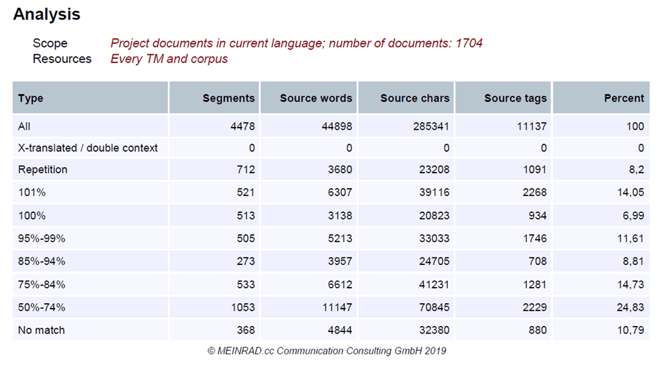 CAT grid, memoQ, machine translation... when reading our blog and browsing our website, you’re bound to come across one or two terms you might not be familiar with. Many of these terms refer to tools which are crucial both for the translation process and for deciding which translation services to buy. This post explains what exactly we mean when we talk about one of them: CAT grids.
CAT grid, memoQ, machine translation... when reading our blog and browsing our website, you’re bound to come across one or two terms you might not be familiar with. Many of these terms refer to tools which are crucial both for the translation process and for deciding which translation services to buy. This post explains what exactly we mean when we talk about one of them: CAT grids.
But in order to understand how CAT grids work, first we need to quickly explain what CAT tools are.
CAT tools
“CAT” stands for “computer-aided translation”, and refers to software used to help translate from one language into another. Three examples of CAT tools are memoQ, SDL Trados Studio and Across.
When you work with a translation agency, this software will be used for various purposes:
-
The translation itself: The translator works in the CAT tool, which gives them access to resources such as translation memories (TMs), term bases and various other features that make their work easier.
-
The review: Once the translation is finished, the reviewer uses the CAT tool to review the translation by comparing it against the source text and making any necessary changes. Some CAT tools have a track changes feature that makes it even easier to see who has made what changes and when.
-
Project management: The CAT tool is probably the most important tool for the project managers at the translation agency. They use it to analyse the source text, and this analysis then serves as the basis for the quote they send the client. It also allows them to assign the project to the right translators and reviewers, respond to queries, monitor the progress of a project and, last but not least, carry out quality assurance checks.
-
Asset management: We have previously explained why we think in-house translation department staff should be renamed “Language Asset Managers”. In addition to managing TMs, updating and maintaining term bases and collating reference materials, they order the translations and therefore work closely with the agency’s project managers. It’s the Language Asset Managers who know their business’s texts and needs better than anyone else – and that means they can help develop a suitable CAT grid.
Now that we’ve explained the basics of how the CAT tool works, let’s take a closer look at how the CAT grid is generated: using the CAT tool analysis of the source text in combination with the TM.
The CAT tool analysis
Translation projects start with a quote created by the project manager, who uses the CAT tool to combine the following to create a new translation project:
- the new documents to be translated,
- the previously translated texts (the TM),
- and the existing term bases.
This lays the foundation for the subsequent analysis in the CAT grid. During the analysis itself, the software does the following:
-
It identifies which sentences (segments) have already been translated.
-
It analyses how similar untranslated segments are to previously translated segments, producing what’s known as the match rate.
The whole thing then looks something like this:
The first column (“Type”) shows the match rate, i.e. how similar the segments in the new source text are to previously translated segments. Here’s what the terms in this column mean:
-
“X-translated / double context”: Used to compare against previous versions of the file, providing even more contextual information than the TM analysis alone and finding better TM matches as a result.
-
“Repetition”: Shows the number of segments that are repeated within the text to be translated.
-
“101%”: “101%” matches are also known as “Context matches”. That means not only is the content of the segment identical (a 100% match) to a previously translated segment, but the segments immediately before and after it are also identical to the previously translated segments before and after the segment in question.
-
“100%”: These segments are identical to a previously translated segment, though the segments before and after are not the same (as they are for 101% matches).
The CAT grid
Once the analysis in the CAT tool is complete and the results of the match categories are displayed, the Language Asset Manager (the client) can start thinking about the CAT grid: that is, the potential pricing levels for each of the match categories. Only a trained, experienced Language Asset Manager (ideally working alongside the agency’s project manager) can assess whether particular pricing levels are right for them.
The following two examples will make clear how the CAT analysis can affect what clients actually pay for their translations:
Scenario 1:
There is a TM containing very good translations, and both the new and previous source texts have been written so that they are suitable for translation (if you’re unsure what we mean by that, and how it can help you save money, this post describes how to make texts suitable for translation). The previously translated segments are sufficiently high-quality that all matches above 85% are easy for the translator to adapt in this new text. In this situation, it’s logical and fair that matches above 85% should be charged at a lower rate – and 101% matches (context matches) aren’t charged at all.
Scenario 2:
There is a TM, but the translations it contains aren’t very good – in fact, this poor quality was the main reason for the client switching to a different translation service provider. The problems were so bad that the translations in the TM can’t simply be used without being reviewed. In this situation, a penalty is applied to the TM so that all its matches are deducted by a certain amount (for example, a penalty of 5% would see a 100% match reduced to 95%). As these segments need to be checked carefully, the rates paid to the translator should be adjusted. The “old” TM would only be used as a reference, i.e. to provide suggestions for future translations, and all reviewed and newly translated segments would then be saved in a new TM.
In short: using CAT grids requires expertise on both sides
These two examples illustrate that the CAT grid used depends on the quality of the source texts and the quality of the existing TMs. Given that CAT grids are also subject to negotiation with individual translators, it’s clear that trained Language Asset Managers are crucial when it comes to discussing a client’s CAT grid options with the language service provider.
If you’re looking to build up your expertise with CAT grids but don’t know where to start, get in touch with us today!
Main image: © MEINRAD


